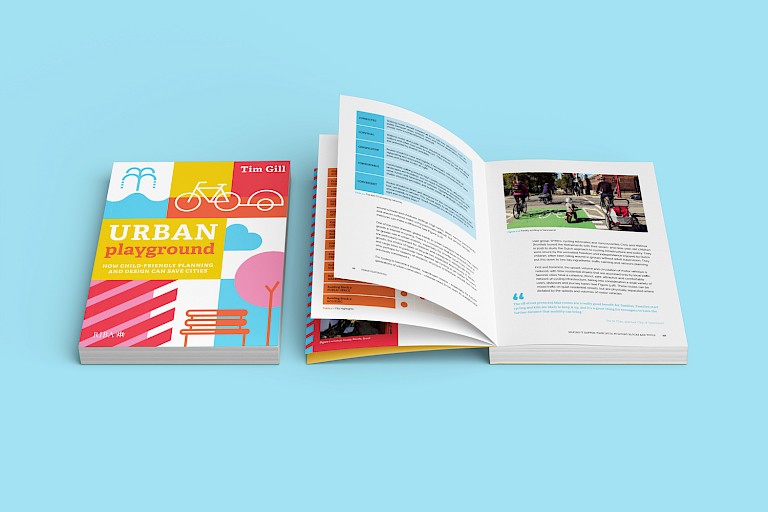
This week I’ve had the pleasure of celebrating the publication of Tim Gill’s new book, ‘Urban Playground: How child-friendly planning and design can save cities’, with the author, Urban Design London, Dinah Bornat of ZCD Architects, a panel of esteemed experts and over 200 people from local authorities, design consultancies and policy makers across Europe. Tim’s book is a must-read for us all, and I hope it will become the seminal publication on the creation of child-friendly cities and find its way to every local authority, design professional, student and commissioning client across the land.
Its aim is to ‘elevate the status of children in city-building, to persuade adults that children’s relationship with cities matters, and to shed light on how it can be improved’. The fact that 60% of the world’s children will live in cities by 2025 illustrates why there needs to be a revolution in this regard. Increasingly there is an appreciation (even in the newly adopted London Plan) that the presence of children indicates the quality of urban habitats for all – children act as ‘the canary’, so to speak. This is no more evident than during the last year, where streets have been transformed into play and social spaces for all ages.
Working as an architect designing housing and neighbourhoods, I’m increasingly aware of three major influences:
- my own reflections on my childhood,
- my experiences raising children of my own in London,
- the direct feedback of communities and their lived experience, in the neighbourhoods where we work.
And my conclusions, based on these influences, are that the strategy and the detail matter equally in the design successful, child-friendly urban environments. You only have to experience Highgate Newtown (1972-78) by Peter Tábori for the London Borough of Camden, where I lived and raised my family for almost 20 years, and see how this has blossomed as a neighbourhood during pandemic, to realise these key components of strategy and detail are fundamental. It was designed, in Peter’s words, to enable ‘a child to find their way home after school on their own’. This has affected every aspect of design – the distribution of buildings, their scale, outlook and relationship, their internal planning, circulation and connection to open space, the linking of routes and shared space and the nuance and subtlety of thresholds and boundaries – the height of a wall or planter, the pairing of front doors, the creation of a view of your neighbour as your search for your keys on the doorstep, the scale of a shared landing.
The longer I work in housing, the more I think of these shared spaces, their connections and blurred boundaries. Interestingly, in Poplar, where we are working with Dinah Bornat and using the new Voice Opportunity Power Toolkit to involve young people in the design of the new masterplan for their neighbourhood, it is clear that this Gen Z group is extremely interested in both strategic design and detail. At a recent workshop they stated that their main concern and urgent need was for safe, connected streets and cycle routes, alongside expressing deep support for those subtle adjustments in design that foster neighbourliness and space to meet and sit.
And, of course, we all know of the direct link between children’s outdoor play and adult activity patterns – and how maximising opportunities to play out safely and naturally within the design of a neighbourhood fosters a strong sense of community and social cohesion, and in turn improves health and wellbeing. If you need any convincing, just look at the diagrams on page 32 of Tim’s book and his study of those three Bristol streets, or have a walk around Highgate Newtown any day of the week. As in Colin Ward’s words, ‘one should be able to play everywhere easily, loosely.’
So, ‘Urban Playground’ is a call to arms, but also a book of hope. Despite London lagging so far behind many other global cities (see table 4.1 in the book), Tim has demonstrated where small design initiatives, alongside visionary political leadership have had huge benefit and impact. Look those school yards and ‘Duimdrops’ in Rotterdam Noord. And we are slowly beginning to wake up to this in London: in Hackney, Islington, Tower Hamlets and beyond – a glance at Olly Wainwright’s terrific recent Guardian article more than proves this – but we have so much more to do.
Seeing cities through children’s eyes does create a unifying lens, as Tim describes, and is at the heart of unlocking inequality in the design of our cities – but it is not just about this. It is about how we do this by placing children and young people at the centre of shaping their own neighbourhoods, before the pencil has even touched the paper. Take a look at Grosvenor, TCPA and ZCD’s toolkit before you next talk to your client.



